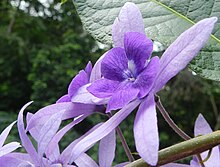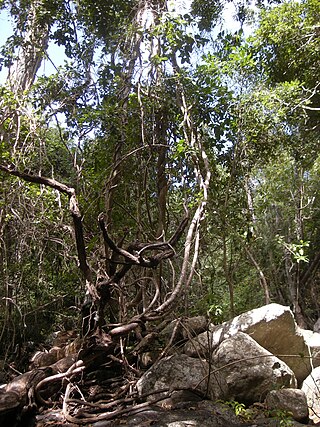
A liana is a long-stemmed, woody vine that is rooted in the soil at ground level and uses trees, as well as other means of vertical support, to climb up to the canopy in search of direct sunlight. The word liana does not refer to a taxonomic grouping, but rather a habit of plant growth – much like tree or shrub. It comes from standard French liane, itself from an Antilles French dialect word meaning to sheave.

Chrysophyllum is a group of trees in the Sapotaceae described as a genus by Linnaeus in 1753.

Petrea is a genus of evergreen flowering vines native to tropical Americas.

Thunbergia alata, commonly called black-eyed Susan vine, is a herbaceous perennial climbing plant species in the family Acanthaceae. It is native to Eastern Africa, and has been naturalized in other parts of the world.

Bougainvillea glabra, the lesser bougainvillea or paperflower, is the most common species of bougainvillea used for bonsai. The epithet 'glabra' comes from Latin and means "bald".

Ipomoea indica is a species of flowering plant in the family Convolvulaceae, known by several common names, including blue morning glory, oceanblue morning glory, koali awa, and blue dawn flower. It bears heart-shaped or 3-lobed leaves and purple or blue funnel-shaped flowers 6–8 cm (2–3 in) in diameter, from spring to autumn. The flowers produced by the plant are hermaphroditic. This plant has gained the Royal Horticultural Society's Award of Garden Merit.

Cordylanthus capitatus, the Yakima bird's-beak or clustered bird's-beak, is an uncommon plant of the Western U.S.
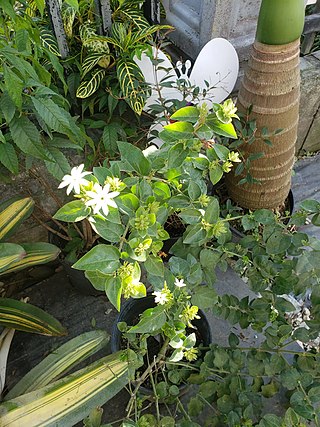
Buxus citrifolia is a species of plant in the family Buxaceae. It is found in Colombia, Panama, and Venezuela. This interesting shrub has not been known to occur in Central America, having only been collected and/or reported in Cuba, Puerto Rico, and Venezuela. Buxus citrifolia is nearly extinct and has been on the endangered list.
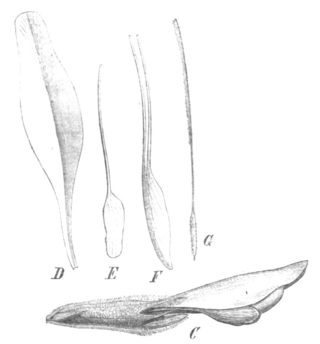
Barbieria is a genus of flowering plants in the legume family, Fabaceae.

Cestrum diurnum is a species of Cestrum, native to the West Indies. Common names include day-blooming cestrum, day-blooming jessamine, and day-blooming jasmine. Also known as Din ka Raja, in Hindi. The scent of this quick-growing and evergreen woody shrub, often used for screens and borders, is released by day. Cestrum diurnum is easily propagated from the seed, which it produces in abundance.

Brunfelsia latifolia, commonly known as yesterday-today-tomorrow and kiss me quick, is a species of flowering plant in the nightshade family. Endemic to Brazil, it is an evergreen shrub that becomes semi-deciduous in cooler areas and grows up to 1.8 meters in height.

Passiflora suberosa is a species of passionflower that is native to the Americas. It is commonly known as corkystem passionflower due to the corkiness of older stems. Other common names include corky passion vine, cork-bark passion flower, corkstem passionflower and corky passionfruit. In Latin America it is called Meloncillo. It is possibly also cryptic and have multiple species in one.
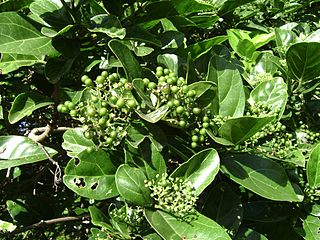
Premna serratifolia is a small tree/shrub in the family Lamiaceae. It flowers and fruits between May and November. During flowering season, it attracts a large number of butterflies and bees. Synonyms of Premna serratifolia Linn. include P. corymbosa Merr., P. integrifolia L. and P. obtusifolia R. Br.).
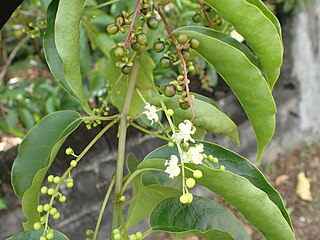
Trichostigma octandrum is a species of flowering plant in the family Petiveriaceae. It was formerly placed in the pokeweed family, Phytolaccaceae. It is native to the Neotropics. It is known in English as hoopvine (Florida), black basket wythe, cooper's wythe, basket wiss or basket with, and hoop with. Common French names include liane pannier or liane a barques. Spanish names include bejuco canesta, sotacaballo, and pabello,. The plant has medicinal and fiber uses.

Lecythis zabucajo, the sapucaia or paradise nut, is a large nut-producing tree occurring in the Guianas, Suriname, Venezuela, Ecuador, Honduras and Brazil, and which distribution range is much the same as that of the greater spear-nosed bat. Although not singling out Lecythis zabucajo, Jacques Huber noted in 1909 that fruit bats played the most important role in seed dispersal in Amazonian forests. The quality of its nuts led to the species' being introduced to numerous tropical countries, notably Trinidad, where it has flourished. The nuts are a valuable food resource and yield oil suitable for cooking and domestic use.

Karomia speciosa is an African deciduous large shrub or bushy tree up to 7 m, and relocated to the family Lamiaceae from Verbenaceae. It is one of 9 species in the genus Karomia, a genus containing species previously classified in Holmskioldia, and is closely related to Clerodendrum. The only remaining species in the genus is Holmskioldia sanguinea, occurring in the foothills of the Himalayas.
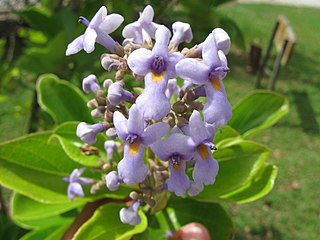
Cornutia is a genus of plants in the family Lamiaceae, first described in 1753. It is native to tropical parts of the Western Hemisphere: southern Mexico, Central America, West Indies, northern South America.
- Cornutia australisMoldenke - Ecuador, Brazil
- Cornutia coerulea(Jacq.) Moldenke - Jamaica
- Cornutia jamaicensisMoldenke - Jamaica
- Cornutia obovataUrb. - Puerto Rico
- Cornutia odorata(Poepp.) Schauer - Venezuela, Colombia, Ecuador, Peru
- Cornutia pubescensC.F.Gaertn. - French Guiana
- Cornutia pyramidataL. - southern Mexico, Central America, West Indies, Suriname, Venezuela, Colombia, Ecuador, Peru
- Cornutia thyrsoideaBanks ex Moldenke - Jamaica
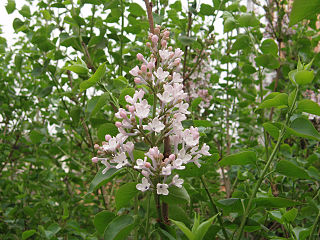
Syringa oblata is a species in the genus Syringa, in the family Oleaceae. It is also known as early blooming lilac or broadleaf lilac.
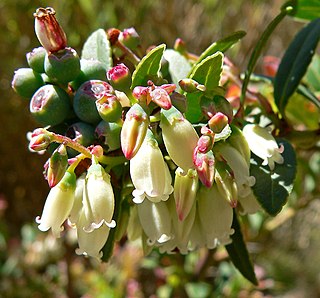
Vaccinium consanguineum or Costa Rican blueberry is a species of Vaccinium found in the montane forests of southern Mexico, Honduras, Costa Rica, and Panama at altitudes of 2100-3100 meters AMSL. In Costa Rica it is found in the Talamanca mountain range and the Central Volcanic mountain range.
Rhizophora harrisonii is a species of plant in the family Rhizophoraceae. It can be found in Brazil, Cameroon, Colombia, Costa Rica, Ecuador, Guyana, French Guiana, Honduras, Nicaragua, Panama, Suriname, Trinidad, Tobago, and Venezuela.

